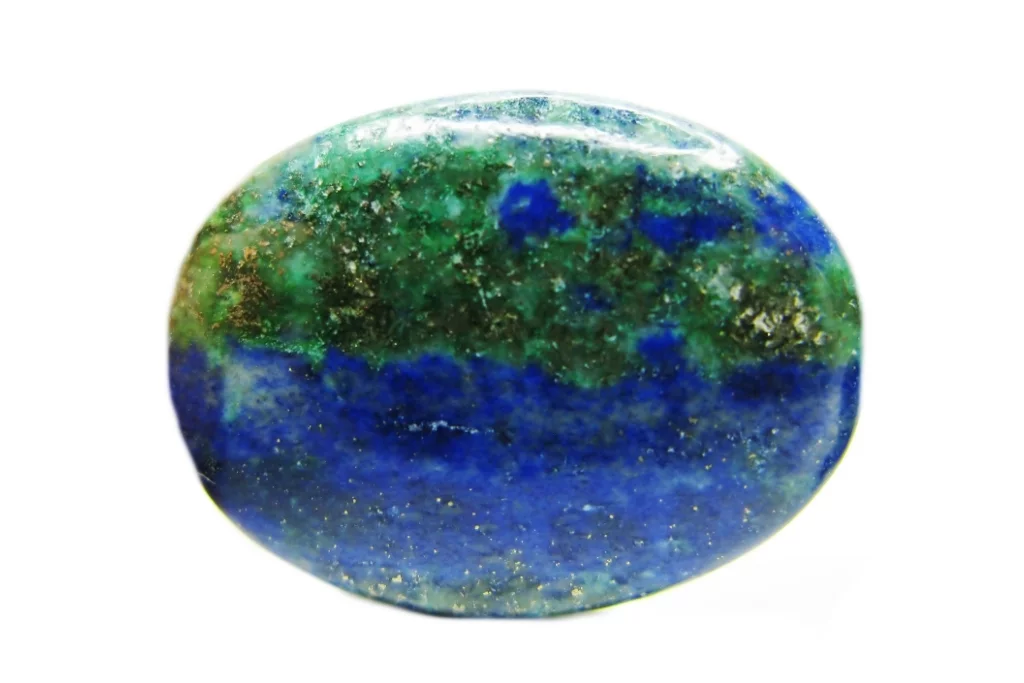Color and Appearance of Azure-Malachite
Azure-malachite is a striking combination of two distinct minerals, azurite and malachite, creating a visually captivating gemstone. The most notable feature of this crystal is its vibrant color palette, which showcases a mesmerizing blend of deep blue and rich green hues. The azure component contributes intense shades of blue ranging from sky blue to deep navy, while the malachite adds various tones of green, from bright emerald to dark forest green.
Crystal Structure and Formation
This unique crystal forms when copper carbonate hydroxide minerals azurite and malachite occur together in the same rock. The resulting structure often displays intricate patterns and swirls where the two minerals intersect. These patterns can appear as bands, spots, or irregular shapes, creating a natural work of art. The crystal structure is typically monoclinic, with azure-malachite often forming in massive, botryoidal, or stalactitic shapes.
Physical Characteristics
Azure-malachite has a Mohs hardness of 3.5 to 4, making it relatively soft compared to many other gemstones. It has a vitreous to silky luster, which gives it a subtle shine when polished. The crystal’s opacity can vary, with some specimens being completely opaque while others may show slight translucency, especially in thinner sections. Due to its softness, azure-malachite is often cut into cabochons or used in ornamental objects rather than faceted gemstones.
Unique Features
What sets azure-malachite apart is its one-of-a-kind color combination and patterning. Each specimen is unique, with no two pieces displaying the exact same arrangement of blue and green. Some crystals may show a more dominant presence of one mineral over the other, while others exhibit a near-perfect balance. The contrast between the cool blue of azurite and the warm green of malachite creates a visually dynamic and aesthetically pleasing gemstone that is highly prized by collectors and jewelry enthusiasts alike.
Historical and Cultural Significance of Azure-Malachite
Azure-malachite, a striking combination of blue azurite and green malachite, has been revered for centuries across various cultures. Ancient Egyptians used it in jewelry and as a pigment in their artwork, believing it possessed protective qualities. In China, azure-malachite was associated with royalty and used in decorative objects for the imperial court. Native American tribes also prized this stone, incorporating it into their spiritual practices and craftsmanship.
Metaphysical Associations
In the realm of crystal healing and metaphysics, azure-malachite is believed to possess a powerful blend of energies. It is thought to combine the transformative properties of malachite with the mental clarity and intuition-enhancing qualities of azurite. Many practitioners believe this stone can help balance emotions, stimulate psychic abilities, and facilitate spiritual growth. It is also associated with the throat and third eye chakras, potentially aiding in communication and inner vision.
Common Uses and Applications
Today, azure-malachite finds applications in both decorative and metaphysical contexts. Jewelry makers often incorporate this eye-catching stone into pendants, rings, and earrings. In crystal therapy, it is used in meditation practices, placed on the body during healing sessions, or carried as a pocket stone. Some people use azure-malachite in their homes or offices as a decorative element, believing it can purify the environment and promote positive energy flow.
Perceived Benefits
Proponents of crystal healing attribute numerous benefits to azure-malachite. It is said to enhance creativity, boost self-confidence, and provide emotional support during times of change. Some believe it can aid in releasing negative thought patterns and past traumas. In physical healing, it is sometimes used to support the immune system and alleviate symptoms of arthritis or joint pain. While these claims lack scientific evidence, many individuals report feeling a sense of calm and balance when working with this unique stone.

